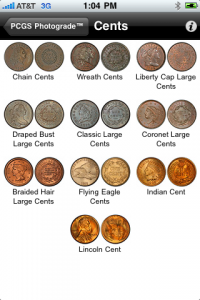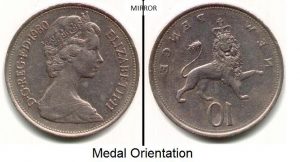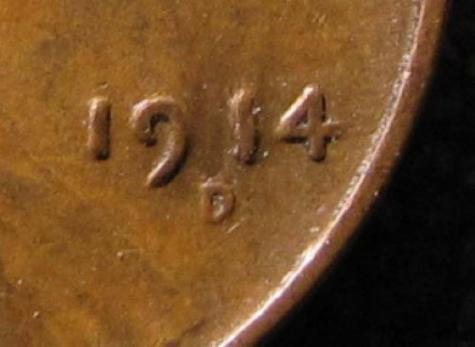This is part 2 of a 6 part series:
- Detecting Counterfeits Introduction
- Visual Inspection ← you are here
- Measurements
- Specific Gravity
- Currency
- Final Word

An example of a Morgan Dollar cut in half to match a date with a mintmark to have the coin appear something it is not.
Although laws are being proposed to help combat the problem, you should take the time to examine the coin, especially if you question its authenticity. Remember, none of these tests are fool proof and failing any one does not mean you have a counterfeit coin. You have to take all the evidence in its entirety to determine if the coin is real or not.
Before you look at the coin, you should be very familiar with the type or have a version of the coin you know to be authentic to compare with it. Although it would be easier of the coin was not in a grading service holder for visual comparison, at least you have a reasonable certainty that an encapsulated coin is authentic.
It helps to have a good magnifier to use to inspect your coin and cotton gloves to prevent the oils from your skin sticking to your prized collectibles.
Orientation
As you look at the coin, flip it over and look at both the obverse and reverse. How is the alignment of the coin? If you are looking at United States coins, you should be able turn it over and the reverse are in the opposite direction of the obverse. This is called “coin alignment.” Some countries produce coins in what is called “medal alignment” where the top of the obverse and reverse designs are in the same direction.
Just because a coin’s alignment is off does not mean the coin is a counterfeit. It is possible that the coin is genuine but was struck by misaligned dies to cause this error. Otherwise, keep the information in the back of your mind as you examine the rest of the coin.
- U.S. coins are struck using coin orientation where if you looked at the reverse in a mirror, the reverse would look upside down.
- Some countries strike their coins using medal orientation where if you looked at the reverse in a mirror, the reverse would look right side up.
Examining the Edge
The edge of the coin is also known as the coin’s third side and the most underestimated area to look. Check the edge for a possible seam that could be the sign of a counterfeit that was cast in a mold rather than struck by a press. Also look for filing or other marks that would suggest the seams were smoothed.

Detecting counterfeit £1 coins, the genuine coin has edge lettering (left), the counterfeit does not.
With the recent rash of counterfeit British £1 coins, we learned that an easy way to tell the fakes from the real coins is to check the edge. If the coin’s edge does not include lettering, the coin is likely a counterfeit.
Surface Examination
Another clue to look for is if there seems to be a surface added to a coin. It will appear like someone put a veneer on top of a metal core. Coins should appear to be solid disks of metal. Even bimetallic coins look and feel like solid coins, even though they are made of two different parts. If you see this veneer-like effect, it is likely that the coin is a counterfeit.
Does the coin supposed to have edge lettering? Remember, some early varieties have coins that have edge lettering, while a later variety has reeds. Make sure you know which version of the coin you are examining and if the lettering on the edge matches the style of a genuine example. Collectors of Presidential dollars know that the lack of edge lettering can be an error by the U.S. Mint and not the sign of a counterfeit.
Some foreign coins have small tooth-like extensions on the surface near the coin’s edge called denticles. While the look of denticles could be different as the die wears, denticles on genuine coins have a sharp, consistent design. Denticles on counterfeit coins may be rounder, more inconsistent, and less dense on the coin—similar to reeded edges. This is where having a good knowledge of the coin you are examining will help you tell the difference between worn denticles produced by worn dies and a counterfeit coin.
Examine the legends and other features of the coin. Do the fonts look right? Is the image proper? Are these elements in the right places? While mistakes happen, it is extremely rare, if not impossible, for many of these elements to be off because of the way all mints make the dies. If the features are consistently incorrect, then the coin is likely to be a counterfeit.
What does the surface look like? Is it dull or have a dull appearance even though the coin is supposed to be of a higher grade? Are the features sharp or do they look rounded? Does the relief of the design look right or is it too flat? If the coin is supposed to be of a higher grade, the sharpness of the detail is important. Although there are coins that were not struck very well, called weak strikes, they will have sharper details than most counterfeit coins.

Click image to read my reviews of PCGS Photograde
On some coins you can see the evidence of the metal flow from the striking process. For some coins, it gives the coin a distinct look—like large silver dollars whose surface gives what is described as a “cartwheel effect” when examined under bright light. Be careful with this test because a lower grade coin has had its surface worn and will not show the cartwheel effect.
If the coin is a cast counterfeit, the surface may look bubbly. While there are examples of planchet (the coin blank) errors where the surface may bubble, these are usually in a small area and looks like small pimples on the coin. A bubbly surface from a cast coin may look similar to the gelatin mold you made where air became trapped inside.
Another sign of a counterfeit coin would be the showing of a different metal under a worn area. If the coin is supposed to be silver but a different color is showing through on a worn area, then it is likely that the coin was plated to give the appearance of silver but was made of a less expensive metal.
Check for Alterations
Finally, check for date and mintmark altering. On a genuine coin, the date and the mint mark looks like it is part of the coin and appears to be “growing” out of the surface. On a counterfeit coin, there are many ways to alter these elements by carving the date, called tooling, or physically cutting the elements from another coin and attaching it to a real coin. This type of alteration is common to change or add a mintmark to a coin.
Use your magnifier to look carefully at the date and mintmark. If there are too many sharp edges or looks damaged from being cut, I would be wary of the coin. Look at the mintmark and the potential grime around it. Does the placement of that grime look like it could have been accumulated over the years of circulation? Or does the pattern of grime not look natural and could be covering up a possible alteration?
- Altering the mintmark and adding “V.D.B” to the reverse of a coin is another trick to fool the buyer.
- Look closely at the mintmark, it is clearly altered from the S you can see shadowed.
Also, know the difference between altered coins and genuine coins where the date was altered in the dies or the mintmark was repunched. Before express travel and fast package shipments, there were times when a branch mint needed to alter dies from another mint or alter dates on the dies so they can continue to strike coins. Rather than filling the die and punching the new date, the coiner would use a punch with the proper number and try to strike it in a way to eliminate most of the previous date. Repunched dates, also called over dates, were more common for coins struck outside of Philadelphia, but have happened in Philadelphia. When you see a catalog listing about a coin with a repunched date, it is written as the date of the coin followed by a forward slash followed by the digits that was previously on the coin. For example, in 1942, the Philadelphia Mint accidentally pressed a 1942 hub with 1941 dies creating the 1942/1 over date that were used in Philadelphia and Denver. Finding one in the lowest grade is worth a lot of money giving counterfeiters a good reason for counterfeiters to try to make one.
If you find a coin that looks like one mintmark is on top of another, or a mintmark looks doubled or tripled, it may be because it is a repunched mintmark. In addition to branch mint sharing dies, dies were shipped from Philadelphia without mintmarks. It was the job of the chief coiner in each branch mint to punch the mintmark into the dies. Sometimes the punch moves when struck giving it a doubled or tripled look. Other times a mintmark filled on the dies and another mintmark is punched over. Re-punched mintmarks are written the same as over dates in the catalogs.
One of the more famous re-punched mintmarks is the 1900-O/CC Morgan dollar. In this case, after the Carson City Mint was closed (CC mintmark), the reverse dies were shipped to the New Orleans Mint (O mintmark). The dies were filed and filled so that the “O” mintmark could be punched on the reverse but whoever did the work did not completely remove the “CC” mintmark. Looking under magnification, you can see the shadow of the original “CC” mintmark that was on the die.
Re-punched dates and mintmarks occurred more often than the U.S. Mint would like to admit. If the coin you are examining has one of these errors, check a reference to see if the it is known. While not finding it in a reference does not mean the coin is counterfeit, it is enough evidence to question whether the coin is genuine of counterfeit.
In the next installment, we discuss what to look for in weight and measurements.
- Orientation images courtesy of user Fuzzy317 at CoinCommunity.com.
- Counterfeit £1 coin image courtesy of BBC News.
- Images of altered coins courtesy of CoinForgeryEbay on Flickr.





